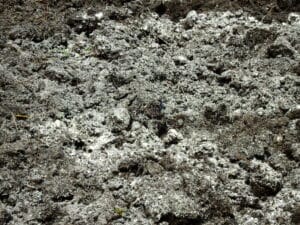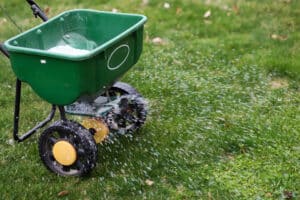When the snow melts and you find white, gray, or pink patches on your lawn, snow mold may be the culprit. This fungus thrives in areas with heavy snowfall and cold winters. While snow mold can look alarming, it’s generally not a lawn killer, and there are manageable steps to help your grass recover in early spring. You can also enlist a top-rated lawn care service for professional assistance.
Get a Quote From Lawn Professionals Near You
Compare quotes from local pros
Clicking “Get Your Estimate” submits your data to Home Service Quotes, which will process your data in accordance with the Home Service Quotes Privacy Policy.

Lime Soil Amendment

Lawn Fertilization
What Is Snow Mold?
Snow mold is a fungal disease that takes root in lawns as snow melts in early spring. It creates circular patches of discolored or dead grass. These patches are often straw-colored and can range from a few inches to more than a foot in diameter. Though the mold lives in the soil year-round, it only becomes active when temperatures are between 32 and 45 degrees Fahrenheit and moisture levels are high.
Snow mold isn’t a serious long-term threat to your lawn. The unsightly patches usually disappear on their own as temperatures rise and grass starts growing again. However, if snow mold covers a large area of your lawn or doesn’t go away after a few weeks, you may need to take steps to repair the damage.
Types of Snow Mold
There are two common types of snow mold that you might encounter on your lawn:
- Pink snow mold (Fusarium patch): This type of snow mold gets its name from its pinkish color, which can range from light pink to dark reddish-brown. Pink snow mold is the more severe of the two types, as it can kill grass roots as well as blades. It’s most common in cool, wet conditions and can occur even without snow.
- Gray snow mold (Typhula blight): This type of mold is white to grayish-white in color and usually appears after the snow melts. It’s less severe than pink snow mold and typically only affects the grass blades, not the roots. Unlike pink snow mold, gray snow mold requires snow cover to thrive.
Why Is Pink Snow Mold More Serious?
Pink snow mold is considered more serious because it can completely kill the grass plants by damaging not just the blades but also the roots. This can cause permanent damage to your lawn if not addressed promptly. It’s also more challenging to prevent because it can remain active and spread at temperatures up to 60 degrees Fahrenheit.
What Kinds of Grass Does Snow Mold Affect?
Snow mold can grow on any type of cool-season turfgrass that is covered by snow for long periods of time. However, according to the University of Illinois’ Integrated Pest Management Department, certain grasses—like bentgrass—are more susceptible to this fungus. Kentucky bluegrass, the most popular cool-season grass, is moderately affected, but fine fescue has more resistance to snow mold than other types.
Removing Snow Mold From Your Lawn
Here’s the bad news: Once you see the snow mold, the damage is already done. Applying fungicide—that is, special chemicals that kill mold—won’t help at that point. The most you can do is gently rake the area to loosen up any matted snow mold grass and allow the soil to dry more quickly.
Once the weather warms up and the soil dries, you’ll have a better idea of how much grass has been affected. Remember that gray snow mold doesn’t kill the roots, so your grass may bounce back from it. For any areas affected by pink snow mold, rake away dead grass and re-seed bare patches.
How Do I Prevent Snow Mold From Growing?
As you may have guessed, the true key to removing snow mold is to prevent it from growing in the first place. Here are some tips for preparing your lawn in the fall before the snow hits.
- DO mow before the first snow. Cut the lawn slightly shorter than normal so that the grass and soil will trap less moisture. Also, consider bagging up your lawn clippings so that they don’t keep the ground damp.
- DO apply a preventative fungicide. If you know your lawn is particularly susceptible to snow mold, treat it with a specialized product before the heavy snow sets in.
- DO dethatch your lawn two or three times a year. Some types of grass produce more thatch than others, so make sure to keep the thatch layer at less than 3/4 inch.
- DO make sure your lawn has proper drainage. Anywhere water pools can create a breeding ground for snow mold, so fill in any low areas with topsoil.
- DON’T fertilize in late fall. Cool-season grasses go dormant in the winter by letting grass blades dehydrate, making them less susceptible to mold. They will revive themselves naturally in the spring. Don’t interrupt this process by fertilizing within about six weeks of the first expected snowfall.
- DON’T let leaves or snow pile up. Anything that traps moisture is bad news for grass, so rake up leaf piles in the late fall. Similarly, when shoveling driveways or sidewalks, try not to create large piles of snow on the lawn that will take a long time to completely thaw.
Restoring Your Lawn
If you find yourself with snow mold in the spring, don’t worry—it will typically resolve itself as temperatures warm up. The snow mold fungus will stop growing when temperatures are between 45 and 60 degrees and the soil starts to dry out.
Until then, if you’re tired of seeing unsightly patches on your lawn, you can gently rake over those areas to dry them out more quickly. Apply new grass seed to repair those spots. Avoid adding fertilizers or fungicides at this point, as they won’t help and will only weaken your lawn as it’s attempting to heal itself.
For help with preventing snow mold or repairing the damage it causes, we recommend TruGreen for all your lawn care needs. We reviewed TruGreen and found it to be our top lawn care choice.
FAQs About Snow Mold
How do you treat snow mold?
Snow mold typically does not require a fungicide treatment. If you gently rake the damaged area, the mold will often die off as the ground and grass dry out.
How bad is snow mold?
Damage from gray snow mold is typically not bad and only affects the blades, so the roots remain healthy. However, pink snow mold affects the grass roots, so the affected grass will likely die.
Where is snow mold found?
Snow mold is found in lawns in climates that receive moderate to heavy snowfall. It often occurs in areas of grass where snow is piled or naturally accumulates.


